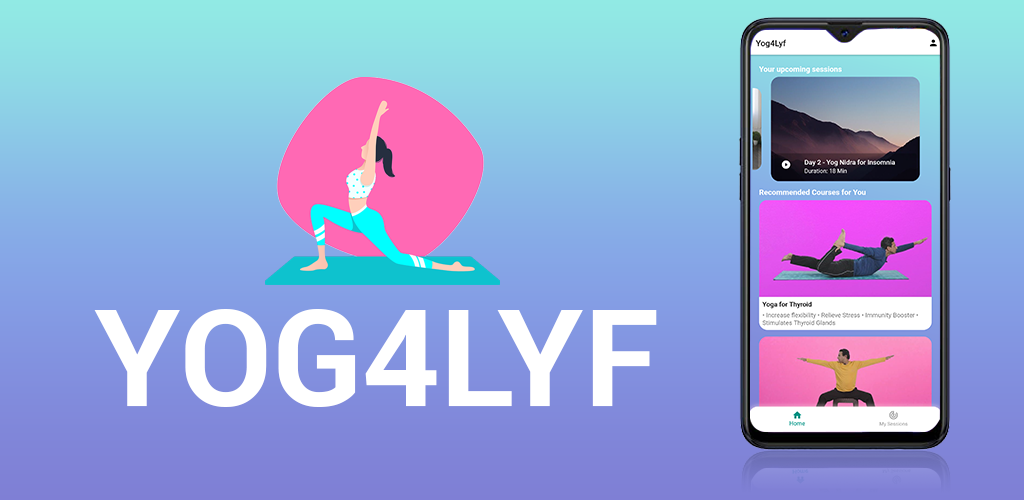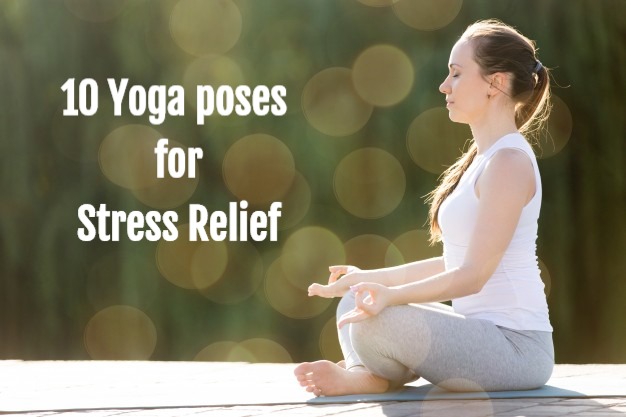When we hear the word Migraine, the first thing that pops up in our head is the throbbing pain and/or a pulsing sensation that comes with it. Those who are prone to Migraines know that it is not an ordinary headache. It’s a combo of headaches clubbed with nausea, vomiting, and dizziness leaving you in constant pain. So in this post, we will understand what exactly is Migraine, and how by introducing yoga asanas and pranayama in your life, you can get relief from migraine.
What is Migraine?

It can be described as a Neurological disorder that leads to severe headaches in one or both sides of your head that can last up to 2 days! Migraine is originated from the Greek word ‘Hemikrania’ where ‘Hemi’ means ‘half’ and ‘Kranion’ means skull. So, it denotes pain on one side of the head. Usually, a person suffering from Migraine starts feeling extreme pain in one side of the head along with nausea, vomiting, and sensitivity to light sound and smell. Some people can sense the aura where visual, sensory, language, or motor disturbance signals for a headache occurring soon. It may last from 2 hours to up to 72 hours and happens due to environment or genetic factors, but usually triggered by factors like stress, loud noise, hormonal changes, and some foods.
What are the Symptoms of Migraine?
Migraine occurs when the imbalance is caused in the brain due to changes in the brainstem and its interactions with the trigeminal nerve. These imbalances in brain chemicals including serotonin, which helps regulate pain in your nervous system. The diagnosis of migraines is determined based on clinical tests based on a pattern of headaches. Many studies have found that women are more likely to experience migraines compared to men.
The symptoms of migraine are divided into four stages
- Pre-drome
- Aura
- Attack
- Post-drome
Pre-drome
Pre-drome is one or two days before the migraine when you might notice subtle changes alarming of an upcoming migraine such as constipation, neck stiffness, increased thirst and urination, food cravings, and mood changes.

Aura
What follows next is the Aura phase. Auras are reversible symptoms of the nervous system causing disturbances that may last from 20 to 60 minutes. Some of the most observed examples are needle sensation in arms and legs, visual phenomena/vision loss, weakness or numbness in the face or one side of the body, difficulty speaking, hearing noises and music, and uncontrollable jerking movements.
Attack
Attack! A migraine if untreated, usually lasts up to 78 hours. The attack is the most severe phase as this is when you experience throbbing pain in one or both sides of the head, sensitivity to light, sound, and sometimes smell and touch, and nausea-vomiting. How often a migraine attack occurs, varies from person to person. It is possible that migraines might occur rarely or strike a couple of times in just one month.
Post-drome
After you experience the attack, you enter the post-drome stage where you might feel completely exhausted and drained out, confused all day. You are required to be extra careful in this phase as any sudden movement might bring the pain back.
Migraine is widespread
- According to WHO, migraine is the third most common disease in the world with 14.7% of estimated global presence, that’s 1 in 7 people!
- Approximately 18% of women, 6% of men, and 10% of children in America are diagnosed with migraines.
- Migraines tend to run in families. About 90% of migraine sufferers have a family history of it.
- Research suggests that 3000 migraine attacks occur every day for each million of the general pollution.
- Severe migraine attacks classified by the World Health Organisation as among the most disabling illness, comparable to dementia, quadriplegia, and active psychosis.
- Less than 50% of migraine patients are satisfied with the current treatment.
- Migraine remains undiagnosed and undertreated in at least 50% of patients, and less than 50% of migraine patients consult a doctor.
How can Yoga help in relieving migraine?
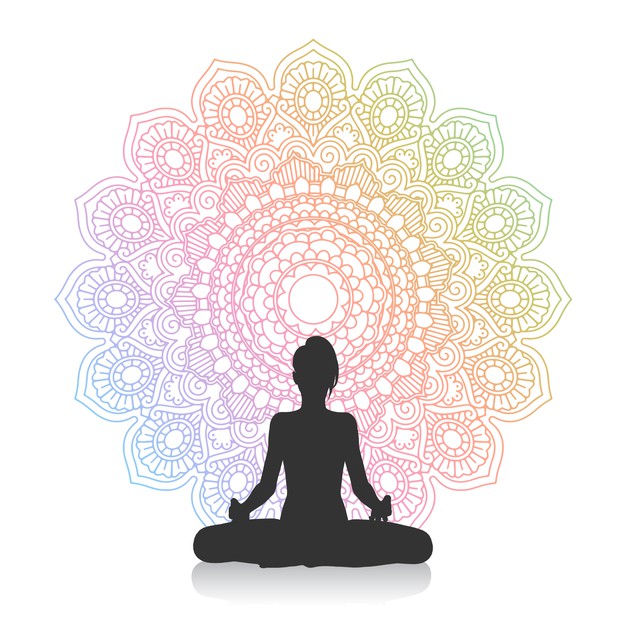
Most people rely on prescription drugs or over-the-counter-medicines to cure migraine attacks, but it may lead to plenty of side effects. However, if you are looking for effective treatment without any side effects, consider yoga. For ages, yoga has shown to improve quality of life and an effective way to cure any disease or disorder in the body. Migraine management through yoga therapy not only reduces the medication costs but also comes with tonnes of positive health benefits. Yoga has the potential to fire up the parasympathetic nervous system, which slows the heart rate, lowers blood pressure, and improves recovery.
Effect of Yoga asanas and pranayama in curing migraine!
Yoga asanas are body postures or alignments practiced to improve mental as well as physical health. Most of these asanas are directly related to blood circulation to the brain. When these asanas are rigorously followed, pure oxygenated blood is supplied to the brain and it can be a positive factor to cure migraine. These asanas when performed with pranayama or breathing exercise, the results are boosted 10 folds.
Pranayama is a breathing technique that is believed to clean 72000 energy channels in the human body. The channels or nadis provide vital energy to different parts of the body by supplying pure filtered blood to the head. This balances the cerebral spinal fluid and stimulates the brain which leads to healthy neurological responses. Scientists believe that pranayama has a positive effect on migraine by fighting the pain with fresh blood circulation all the time. When all the functions of the brain and the nervous system are properly maintained, the chances of migraine attacks become slim.
Let’s take a look at some of the most effective pranayama/breathing exercises and yoga asanas that are extremely helpful in curing Migraines.
Yoga Pranayama for Migraine
1. Alternative nostril breathing | Anulom Vilom

Steps:
- Sit comfortably on your mat and sit straight so that your back, neck, and head are aligned.
- Let your left-hand rest on your left knee.
- There is this particular hand pose that one has to perform with his right hand. There is a reference image. You have to curl up your index and middle finger and let the other fingers be open and not curled up.
- Maintaining the same hand pose, use your thumb to press your right nostril and inhale deeply from your left nostril.
- Hold your breath for 5 seconds and then press your left nostril with your ring finger and lift your thumb from your right nostril and exhale slowly.
- Keep repeating this 15-20 times.
Precautions:
- Avoid practicing it if you are suffering from high blood pressure or any heart disease.
2. Kapalbhati | Skull shining breath

Steps:
- Sit comfortably on your mat and sit straight so that your back, neck and head are aligned.
- Inhale normally and exhale forcefully through your nostrils only.
- Keep inhaling and exhaling in this manner for 30 -50 seconds.
Precautions:
- Avoid Kapalbhati if you are pregnant.
- Avoid if you are suffering from high blood pressure or heart-related discomforts
- Not to be practiced when having an asthma attack.
Yoga Poses for Migraine
1. Forward Bend | Uttanasana | Yoga for Migraine
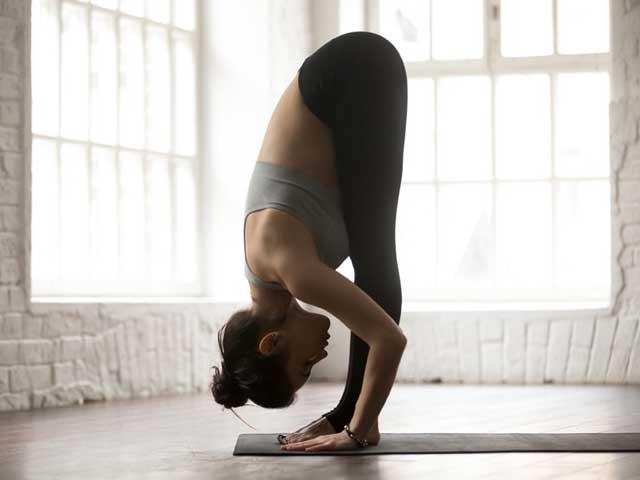
Steps:
- Stand straight on the ground and maintain distance between your feet.
- Raise both your arms together towards the sky with a deeply focused inhalation.
- Exhale and bend forward, letting your palm touch the floor.
- Your hips would act as a common point between the upper body and lower body, maintain balance.
- Feel your back stretching in opposite directions as you pull the head down and in and press the hips up.
- Breathe and hold for 4-8 breaths, pressing the belly into the thighs on the inhalation.
Precautions:
- You need to refrain from practicing this pose if you face chronic problems or have a history of any injury in your knee joints, ankle joints, or back.
2. Bridge Pose | SetubandhAsana | Yoga for Migraine

Steps:
- Lying on your back, bend both knees and place the feet flat on the floor hip-width apart.
- Place your arms alongside the body with the palms facing down.
- The fingertips should touch the heels.
- Inhale and lift the hips up, by giving a little pressure on the feet towards the floor.
- Lift your chest up with the support of your arms and shoulders.
- Please note that your shoulders and arms should be resting on the floor.
- Breathe and hold for 4-8 breaths.
- To release: exhale and gently place your spine back to the floor.
Precautions:
- Avoid practicing this pose if you are suffering from neck or back pain.
- Avoid the yoga pose if one is having any knee pain.
- Avoid it during a shoulder injury.
- Avoid moving your head left or right.
- Do not put more pressure on the neck.
3. Child’s Pose | Balasana | Yoga for Migraine
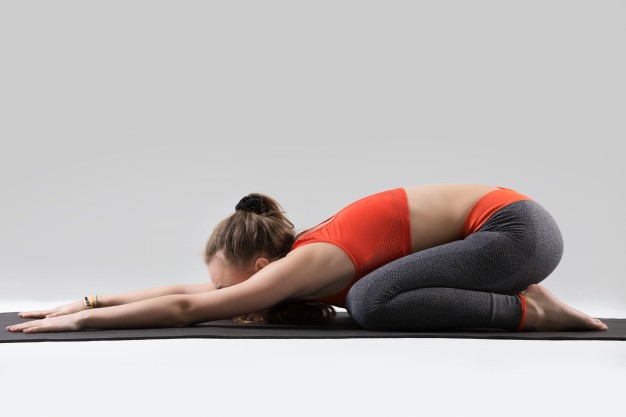
Steps:
- Kneel on your knees and keep your knees at a distance parallel to your hips.
- Bend down and let your palm touch the floor.
- Stretch your hands as much as possible.
- Let your face position itself between your hands and touch the floor.
- Now let your buttocks touch your heels slowly.
- Keep breathing slowly, focusing on your breathing.
- Stay in the same position for 30 seconds for beginners, later you can increase the time up to 2-3 minutes.
Precautions:
- Avoid this pose if you are suffering from diarrhea.
- If you are pregnant, then spread your knees wider and do not apply more pressure on the abdominal area.
- Avoid child pose if you have any knee injuries.
4. Cat-Cow pose | Yoga for Migraine

Steps:
- First, come to a position same as a baby crawling that would be palms on the floor and knees on the floor.
- Be in a neutral position with your head and neck and spine aligned.
- Then we will begin with Cow Pose, so inhale when you drop your belly towards the mat. Lift your chin and chest, and gaze up toward the ceiling.
- Then, we will move to Cat Pose, you exhale and push your belly to your spine and round your back toward the ceiling. The pose should look like a cat stretching its back.
- Inhale, coming back into Cow Pose, and then exhale as you return to Cat Pose.
- Repeat 5-20 times and rest.
Precautions:
- Avoid this pose if you have any knee injury.
- A pregnant woman should also avoid this pose and it might stress the belly or practice it when supervised.
5. Seated Forward Bend | Paschimottasana
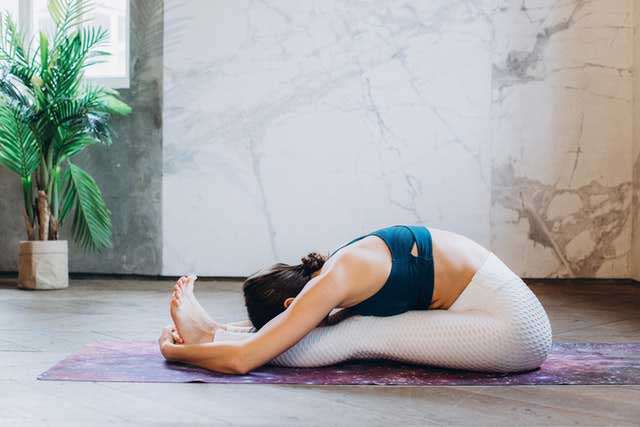
Steps:
- Sit straight on the ground, stretching your legs out front.
- Make sure your toes are together pointing forwards.
- Now, breathe in, raise your arms above, and stretch up.
- Breathe out, bend forward from hip joints. Make sure your spine is erect and move forwards towards the toes, not downwards towards your knees.
- Try grabbing your toes with your fingers and if you’re unable to do that, place your hands on your legs as far as you can. The nose should touch the knees.
- Inhale and slightly lift your head and lengthen your spine.
- Move the navel towards the knees while breathing out.
- Breathing in, stretch your arms out in front of you and slowly come back to normal position.
- Breathe out and lower the arms.
Precautions:
- Avoid this asana if you have lower back pain, diarrhea, Asthma, or slip disk. Do not bend beyond your comfort level.
6. Downward Facing Dog Pose | Adho Mukha Svanasana

Steps:
- Stand straight on your legs then bend forward.
- Place your palms on the floor, note that your fingers are widely spread and balanced.
- There should be enough space between your knees and palm.
- Now, take note that your wrists are exactly aligned with your shoulder, and knees aligned with hips.
- Stretch your elbows and let your upper back relax.
- Lift both your knees from the floor and raise your pelvis too.
- Straighten your legs gradually, as straight as possible.
- Bring your body into the shape of the alphabet ‘A’.
- Stay stable and do not change the distance between your palms and feet.
- Draw your shoulder blades into your upper back ribs and toward your tailbone.
- Hold this position for 30 seconds and later you can increase your time limit.
- To relax from that position, relax your knees and bend down.
Precautions:
- If the person practicing this pose has stiff or weak back muscles, tight hamstrings, sciatica, or knee problems should practice this pose gently and gradually easing in and out of the pose while keeping the knees bent and back straight.
- Those with Carpal Tunnel Syndrome should press down into the base of their fingers.
7. Wide Legged Standing Forward Bend | Prasarita Padottanasana | Yoga for Migraine
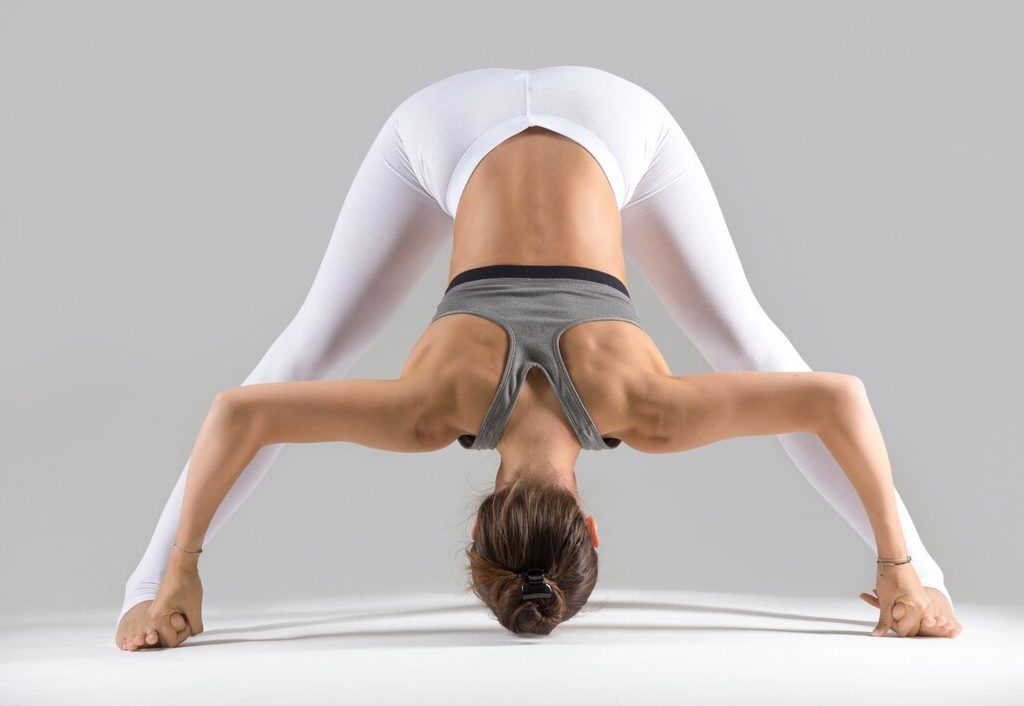
Steps:
- To begin with, stand in Tadasana with feet wide apart. You are aiming for stability and grounding.
- Exhale and lean forward your torso from the hip joint keeping the torso straight. Extend your elbows; your legs and arms should be perpendicular to the floor and parallel to each other.
- Try to push your thighs straight back up to lengthen your front torso and draw your inner groins away from each other to widen the base of the pelvis.
- Press your palms firmly to the floor. Make sure to keep your arms parallel to each other and widen the shoulder blades across the back.
- Stay in this pose for 30 seconds to one minute as per your convenience.
- To come out, bring lift your torso slowly and walk your hands forward to place them below your shoulders. Then with an inhalation, rest your hands on the hips, pull your tailbone downward and swing the torso up. And finally, walk your feet back to Tadasana.
Precautions:
- Avoid in case of lower back problems.
- Be cautious not to overstretch your hamstrings.
- Distribute your weight evenly.
8. Janu Shirasana | Head to knee pose | Yoga for Migraine

Steps:
- Firstly, sit on the floor with legs stretched out in front of you. Keep your back erect. You may use a blanket under your hips if necessary.
- Bend your right knee; place the bottom of your right foot against the inner part of your left thigh. Your right leg and knee should be comfortably pressed on the floor.
- See that your chest and navel are lined up with your left leg, setting your torso in the right position.
- Your hands must be placed right beside the hips. Let your hands provide support.
- Inhale and extend your belly and torso right up to the top of your head.
- While you exhale, let the energy pass through your left leg till the ball of the foot.
- Inhale and stretch your arms such that it lengthens your spine. Then exhale and slowly bend forward from your hips. Try to reach your ankles or toes with your hands or stretch till you are comfortable.
- Hold this position while you take a few deep breaths.
- To release this pose, lift your torso and stretch out your right leg. Let the muscles in your abdomen contract.
- Relax for a few seconds and repeat this for another side.
Precautions:
- Avoid this asana if you have diarrhea or Asthma.
- Do not flex too much in case of a knee injury. Instead, use a folded blanket for support.
9. Cobra Pose | Bhujangasana | Yoga for Migraine

Steps:
- To begin with, first, lie down flat on your stomach.
- Place your legs comfortably and toes touching the floor and sole facing the roof.
- Then place your palm near your chest,
- Keep your elbows closely tucked inside.
- Then without moving your lower body, raise your upper body supported by your hands.
- Keep breathing normally and stay in the same position for 30 second
- Withdraw from that position, take a rest, and try again for more than 30 seconds.
Precaution:
- Do not practice Cobra pose, if you have any recent back or wrist injury.
- Avoid if you are pregnant.
10. Camel Pose | Ushtrasana

Steps:
- First of all, kneel down on the floor.
- Keep your thighs and feet together.
- Toes should be pointing back and resting on the floor.
- Bring the knees and the feet about one foot apart and stand on the knees.
- Inhale, bend backward slowly.
Precautions:
- Avoid this pose if you are suffering from high or low blood pressure.
- Avoid it if you are suffering from Insomnia
11. Shoulder Stand Pose | Sarvangasana

Steps:
- To begin with, lie down on your back with your hands on the side.
- Gently lift your legs, buttocks, and back such that you come up high on your shoulders. You can use your hands to support your back.
- Inhale and raise the back and legs up into a vertical position. Your chin should rest against the chest, creating a chin lock.
- Keep your legs firm and fix your eyesight on the toes as you maintain balance.
- Continue normal breathing and remain in this position for about 30-60 seconds.
- To come out, inhale and while exhaling, bend the waist and lower the legs over the head. Bring your hands to the floor.
- Inhale and lower your back on the floor keeping your legs at 90 degrees. Be very gentle while your lower your back. Then slowly lower your legs back to the starting position.
Precautions:
- You will have to be extra careful while performing this asana. Perform each pose very slowly and gently to avoid any mishaps.
- People suffering from high blood pressure, heart diseases, and brain conditions should avoid this asana.
- Avoid if you are suffering from slip disc, enlarged thyroid, headache, or cervical spondylitis.
12. Corpse Pose | Shavasana
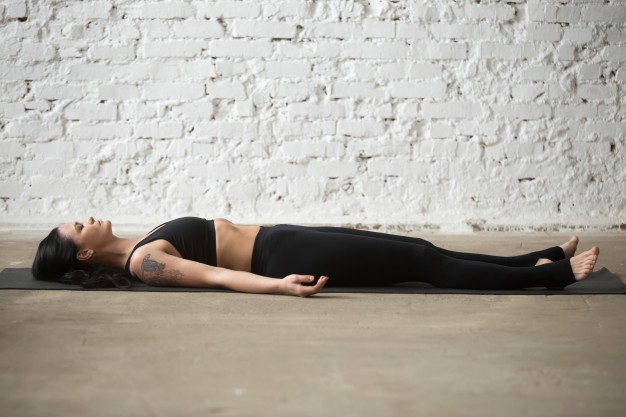
Steps:
- Lie flat on the floor keeping your back straight.
- Your palms, facing upwards, must be placed slightly apart from your body.
- Close your eyes and place your legs comfortably apart from each other. Make sure your toes are facing sidewards.
- Keeping your head and spine in a straight line, lay peacefully.
- Take a deep breath, draw attention to every part of your body.
- Breathe slowly, setting your body in a state of deep relaxation. Let it soothe your body, mind, and soul.
- Forget everything and try to focus on your body while breathing. Feel each and every breath going in and out.
- Remain in this position for a few minutes (make sure you don’t fall asleep) and slowly come back to your normal position.
Precautions:
- Avoid doing this Asana in a noisy/disturbing environment.
- Make sure not to move your body while performing this asana. You need to remain completely still as even the slightest movement may disturb your practice.
There are many ways to overcome migraine pain such as occipital nerve stimulation, muscle surgery, arterial surgery are few of the various preventive methods to prevent migraine attacks. But you need to know that these methods may come with side effects and opting some of these may cure migraine but also increase the risk of hypertension, heart attacks, and insomnia. Nowadays, yoga is considered as an effective alternative to fight several disorders without any medicine. Yoga is a holistic approach to fight migraines and has been proven to significantly reduce or lower the pain. Yoga has no side effects, however, it is advised to practice yoga under expert supervision.
